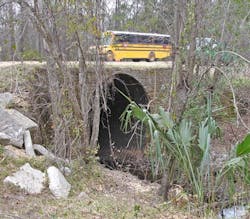The test of time
Eight years ago, a portion of Florida State Route (SR) 16 was beginning to subside as a result of heavy tropical storm flows. A large void had opened up on one side of the culvert running underneath the roadway, and the culvert was visibly rusting and failing. The 13-ft-diameter bolted multi-plate culvert is close to the surface of the roadway, with only a foot at the crown of the roadway and tapering to just 10 in. from the top of the pavement to the culvert at the edge of the paved two-lane highway. To save the road, the culvert needed immediate structural repair.
Emergency repairs
Given the relatively thin cover and the void, it was clear that any rehabilitation technique used had to have extreme structural strength. This ruled out sliplining and cured-in-place pipe, which also would have been expensive at this diameter. To make matters more challenging, the Florida Department of Transportation (FDOT) and the affected Florida counties of Clay and Nassau wanted to keep SR 16 open during rehabilitation, as it is an important truck route connection. In response to these circumstances, FDOT and Transfield Services, the contracted regional maintenance managers, decided to use CentriPipe PL-8000.
“It’s a newer application for this type of product,” said Spencer Townsend, Transfield Services regional maintenance manager for the project. “[Engineered by AP/M Permaform], PL-8000 is very high-strength and it has an additive that makes it very sticky, so it’s perfect for shooting on a pipe.”
Engineered to provide a structurally sound pipe or culvert independent of the failing substrate, the solution was sprayed onto the internal walls of failing structures. The resulting concrete has thin-section toughness, high modulus of elasticity and self-bonding properties.
In this culvert rehabilitation, the total thickness was a 2-in. layer of new concrete in a failing 13-ft-diameter corrugated metal pipe. This thickness was designed and certified by engineers for the rehabilitation to ensure a minimum cover of 1 in. over the culvert’s protruding bolts.
During the culvert rehabilitation, traffic never stopped, the rehabilitation supported the roadway, and the new concrete culvert had little effect on flow volume due to its thinness and its smoothness.
Lasting performance
In late 2016, FDOT and others were interested in the solution’s long-term performance. Visual inspection and sophisticated strain gauge testing of the SR 16 culvert provided evidence that the solution was a structurally sound and long-lasting rehabilitation technology.
“The strain data show that the movements under heavy truck loading were minor and that this 13-ft-diameter corrugated metal pipe, which was lined in 2010, continues to perform well,” said Robert S. Kosey, P.E., FDOT District 2 maintenance engineer.
Many designers contemplating trenchless sewer rehabilitation have asked for verification of the structural performance of PL-8000 and the system as a whole. The evaluation of the SR 16 culvert proved to be an opportunity to answer these questions.
“We did an initial walkthrough in January 2016, and it was actually just below freezing, which is unusual here in Florida,” said Scott Kelly, regional manager for AP/M Permaform. “And just visually, the rehabilitated culvert still looked brand new. The condition of the liner was incredible. No fractures, no voids, no visible wear—it was very satisfying.
“I’m often talking to engineers who buy into the ‘thicker is better’ school of thought,” Kelly said. “This is understandable, but frustrating. With our process, a new concrete lining that looks thin, compared to competing solutions, really is better because it’s stronger, performs better structurally and doesn’t have a significant impact on culvert flow volumes.”
The absence of fractures from heavy live loads proved that the lining was holding up to traffic loads. Additional independent testing was performed by Resensys LLC, a company that devises sensors and testing protocols to detect strains and stresses in existing infrastructure, such as bridges and roadways. In November 2016, Resensys installed four sensitive strain sensors evenly spaced along the 96-ft-long culvert crown at the top inner surface, as well as a data logger to record data from the sensors. The culvert then was deliberately subjected to extreme load testing.
“Basically, I arranged for a loaded 18-wheeler with verified weight of 83,620 lb to drive over the culvert in both directions, stopping each way with cab axles and then trailer axles directly over the crown of the culvert,” Kelly said.
Axle alignment was verified visually with an alignment tool and by monitoring the strain gauges during truck movement. Redundant methods were used to ensure truck weight was placed to have maximum impact. The sensors showed that the loading effects were negligible.
“During truck tests of Nov. 22, 2016, very little strain change was observed, and as a result, it is logical to assume that the structure can carry load up to (and possibly even larger than) the weight of the truck used when the tests were conducted,” according to the Resensys report. Live load testing also was conducted with the sensors left in place and data continuously recorded Nov. 22 to Dec. 9.
The Resensys report found that no strain change was caused by traffic and that there was no transient strain change found during the reporting period, implying the structure’s safe load carrying capacity under existing traffic conditions. The observation was consistent with the truck test loads conducted earlier.
“This data validates the use of PL-8000 here, and also validates the design methodology used,” said Ed Kampbell, president of Rehabilitation Resource Solutions. “Most engineers would have predicted a lot of give or bending, but that wasn’t observed. As applied, the material went into compression, showing that even shallow cover provided a significant amount of support. These are very useful results for engineers working on culvert rehabilitations.”
